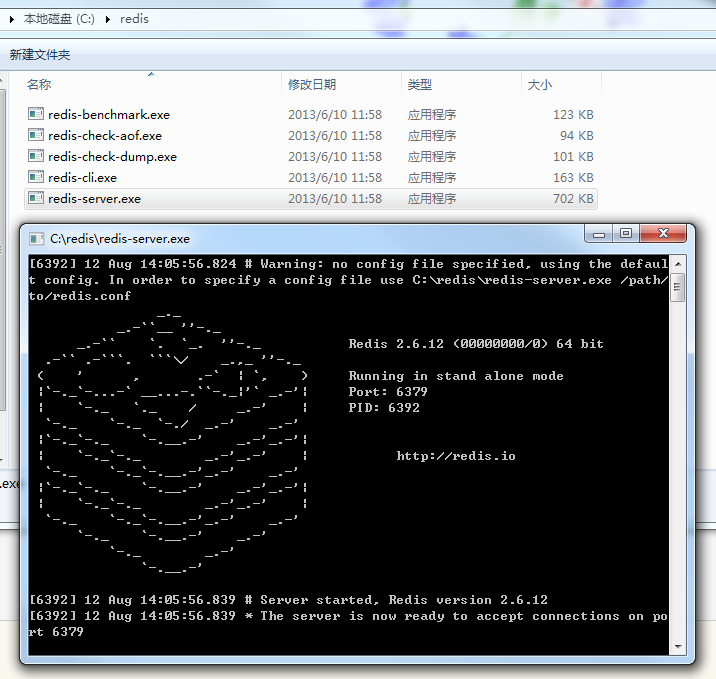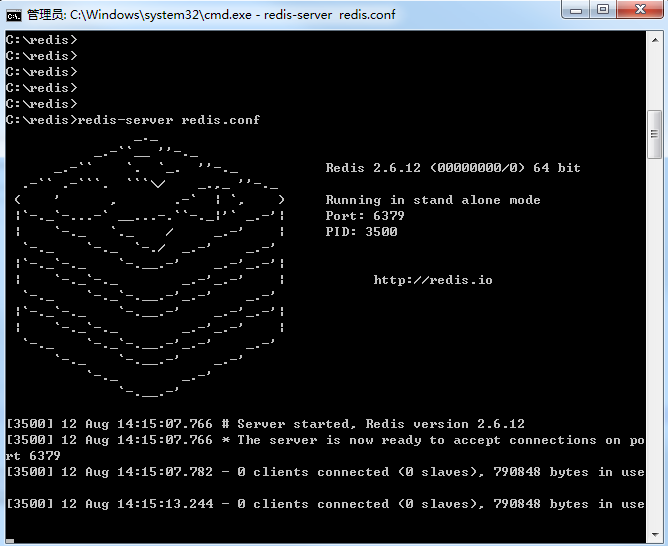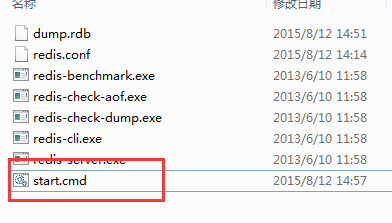下载安装:

redis-server.exe redis服务器的daemon启动程序 redis.conf redis配置文件 redis-cli.exe redis命令行操作工具。当然,也可以用telnet根据其纯文本协议来操作 redis-check-dump.exe 本地数据库检查 redis-check-aof.exe 更新日志检查 redis-benchmark.exe 性能测试,用以模拟同时由N个客户端发送M个 SETs/GETs 查询 (类似于 Apache的 ab 工具)
上面是使用默认的config来启动redis,如果需要修改默认配置可以在redis的根目录下建立redis.conf文件,内容参考:
# Redis configuration file example # By default Redis does not run as a daemon. Use 'yes' if you need it. # Note that Redis will write a pid file in /var/run/redis.pid when daemonized. daemonize no # When run as a daemon, Redis write a pid file in /var/run/redis.pid by default. # You can specify a custom pid file location here. pidfile /var/run/redis.pid # Accept connections on the specified port, default is 6379 port 6379 # If you want you can bind a single interface, if the bind option is not # specified all the interfaces will listen for connections. # # bind 127.0.0.1 # Close the connection after a client is idle for N seconds (0 to disable) timeout 300 # Set server verbosity to 'debug' # it can be one of: # debug (a lot of information, useful for development/testing) # notice (moderately verbose, what you want in production probably) # warning (only very important / critical messages are logged) loglevel debug # Specify the log file name. Also 'stdout' can be used to force # the demon to log on the standard output. Note that if you use standard # output for logging but daemonize, logs will be sent to /dev/null logfile stdout # Set the number of databases. The default database is DB 0, you can select # a different one on a per-connection basis using SELECT <dbid> where # dbid is a number between 0 and 'databases'-1 databases 16 ################################ SNAPSHOTTING ################################# # # Save the DB on disk: # # save <seconds> <changes> # # Will save the DB if both the given number of seconds and the given # number of write operations against the DB occurred. # # In the example below the behaviour will be to save: # after 900 sec (15 min) if at least 1 key changed # after 300 sec (5 min) if at least 10 keys changed # after 60 sec if at least 10000 keys changed save 900 1 save 300 10 save 60 10000 # Compress string objects using LZF when dump .rdb databases? # For default that's set to 'yes' as it's almost always a win. # If you want to save some CPU in the saving child set it to 'no' but # the dataset will likely be bigger if you have compressible values or keys. rdbcompression yes # The filename where to dump the DB dbfilename dump.rdb # For default save/load DB in/from the working directory # Note that you must specify a directory not a file name. dir ./ ################################# REPLICATION ################################# # Master-Slave replication. Use slaveof to make a Redis instance a copy of # another Redis server. Note that the configuration is local to the slave # so for example it is possible to configure the slave to save the DB with a # different interval, or to listen to another port, and so on. # # slaveof <masterip> <masterport> # If the master is password protected (using the "requirepass" configuration # directive below) it is possible to tell the slave to authenticate before # starting the replication synchronization process, otherwise the master will # refuse the slave request. # # masterauth <master-password> ################################## SECURITY ################################### # Require clients to issue AUTH <PASSWORD> before processing any other # commands. This might be useful in environments in which you do not trust # others with access to the host running redis-server. # # This should stay commented out for backward compatibility and because most # people do not need auth (e.g. they run their own servers). # # requirepass foobared ################################### LIMITS #################################### # Set the max number of connected clients at the same time. By default there # is no limit, and it's up to the number of file descriptors the Redis process # is able to open. The special value '0' means no limts. # Once the limit is reached Redis will close all the new connections sending # an error 'max number of clients reached'. # # maxclients 128 # Don't use more memory than the specified amount of bytes. # When the memory limit is reached Redis will try to remove keys with an # EXPIRE set. It will try to start freeing keys that are going to expire # in little time and preserve keys with a longer time to live. # Redis will also try to remove objects from free lists if possible. # # If all this fails, Redis will start to reply with errors to commands # that will use more memory, like SET, LPUSH, and so on, and will continue # to reply to most read-only commands like GET. # # WARNING: maxmemory can be a good idea mainly if you want to use Redis as a # 'state' server or cache, not as a real DB. When Redis is used as a real # database the memory usage will grow over the weeks, it will be obvious if # it is going to use too much memory in the long run, and you'll have the time # to upgrade. With maxmemory after the limit is reached you'll start to get # errors for write operations, and this may even lead to DB inconsistency. # # maxmemory <bytes> ############################## APPEND ONLY MODE ############################### # By default Redis asynchronously dumps the dataset on disk. If you can live # with the idea that the latest records will be lost if something like a crash # happens this is the preferred way to run Redis. If instead you care a lot # about your data and don't want to that a single record can get lost you should # enable the append only mode: when this mode is enabled Redis will append # every write operation received in the file appendonly.log. This file will # be read on startup in order to rebuild the full dataset in memory. # # Note that you can have both the async dumps and the append only file if you # like (you have to comment the "save" statements above to disable the dumps). # Still if append only mode is enabled Redis will load the data from the # log file at startup ignoring the dump.rdb file. # # The name of the append only file is "appendonly.log" # # IMPORTANT: Check the BGREWRITEAOF to check how to rewrite the append # log file in background when it gets too big. appendonly no # The fsync() call tells the Operating System to actually write data on disk # instead to wait for more data in the output buffer. Some OS will really flush # data on disk, some other OS will just try to do it ASAP. # # Redis supports three different modes: # # no: don't fsync, just let the OS flush the data when it wants. Faster. # always: fsync after every write to the append only log . Slow, Safest. # everysec: fsync only if one second passed since the last fsync. Compromise. # # The default is "always" that's the safer of the options. It's up to you to # understand if you can relax this to "everysec" that will fsync every second # or to "no" that will let the operating system flush the output buffer when # it want, for better performances (but if you can live with the idea of # some data loss consider the default persistence mode that's snapshotting). appendfsync always # appendfsync everysec # appendfsync no ############################### ADVANCED CONFIG ############################### # Glue small output buffers together in order to send small replies in a # single TCP packet. Uses a bit more CPU but most of the times it is a win # in terms of number of queries per second. Use 'yes' if unsure. # glueoutputbuf yes # Use object sharing. Can save a lot of memory if you have many common # string in your dataset, but performs lookups against the shared objects # pool so it uses more CPU and can be a bit slower. Usually it's a good # idea. # # When object sharing is enabled (shareobjects yes) you can use # shareobjectspoolsize to control the size of the pool used in order to try # object sharing. A bigger pool size will lead to better sharing capabilities. # In general you want this value to be at least the double of the number of # very common strings you have in your dataset. # # WARNING: object sharing is experimental, don't enable this feature # in production before of Redis 1.0-stable. Still please try this feature in # your development environment so that we can test it better. # shareobjects no # shareobjectspoolsize 1024
然后使用redis.conf启动redis:

为了方便起见,建议建立一个start.cmd文件,里面输入如下内容:
redis-server redis.conf
